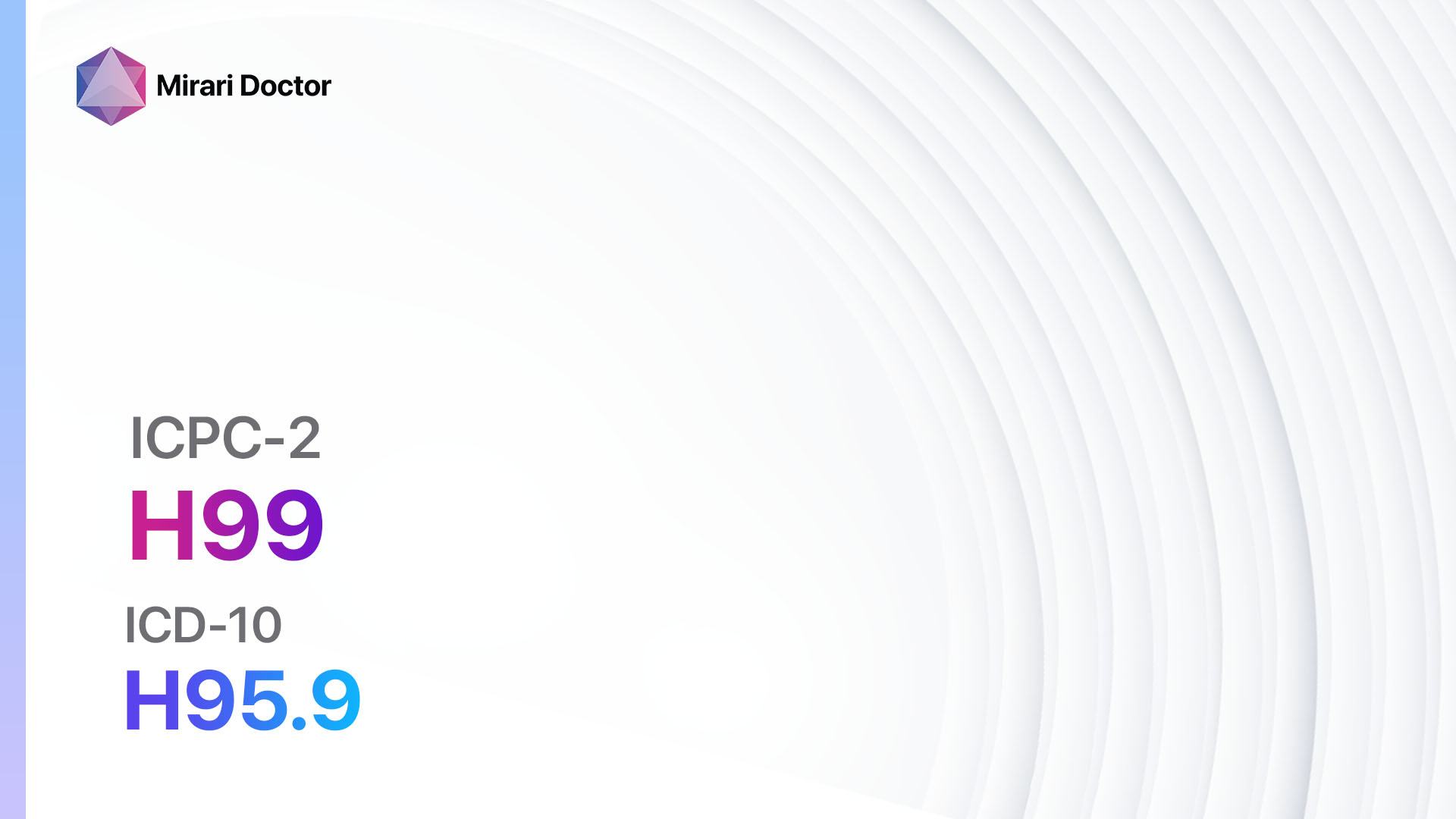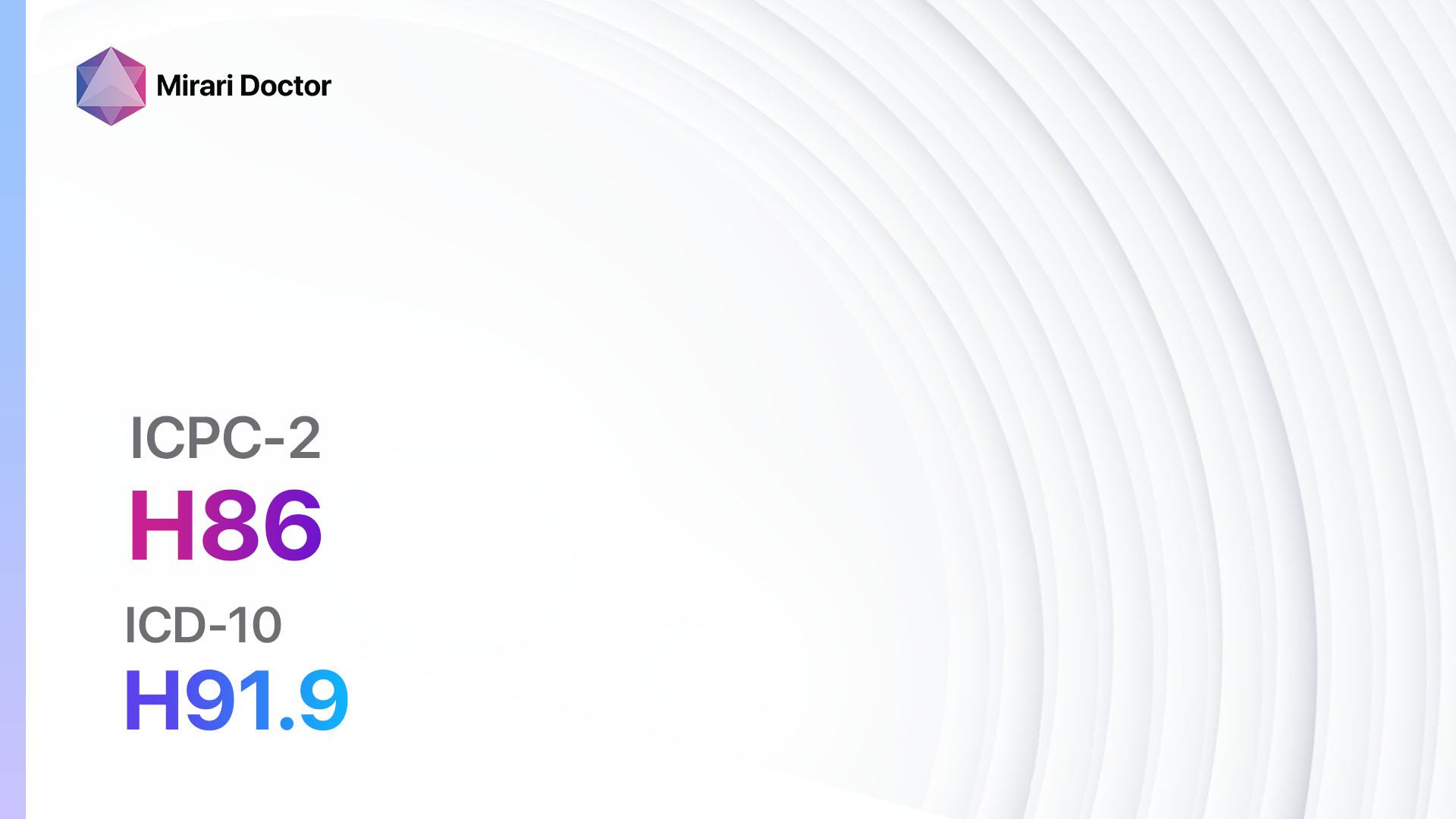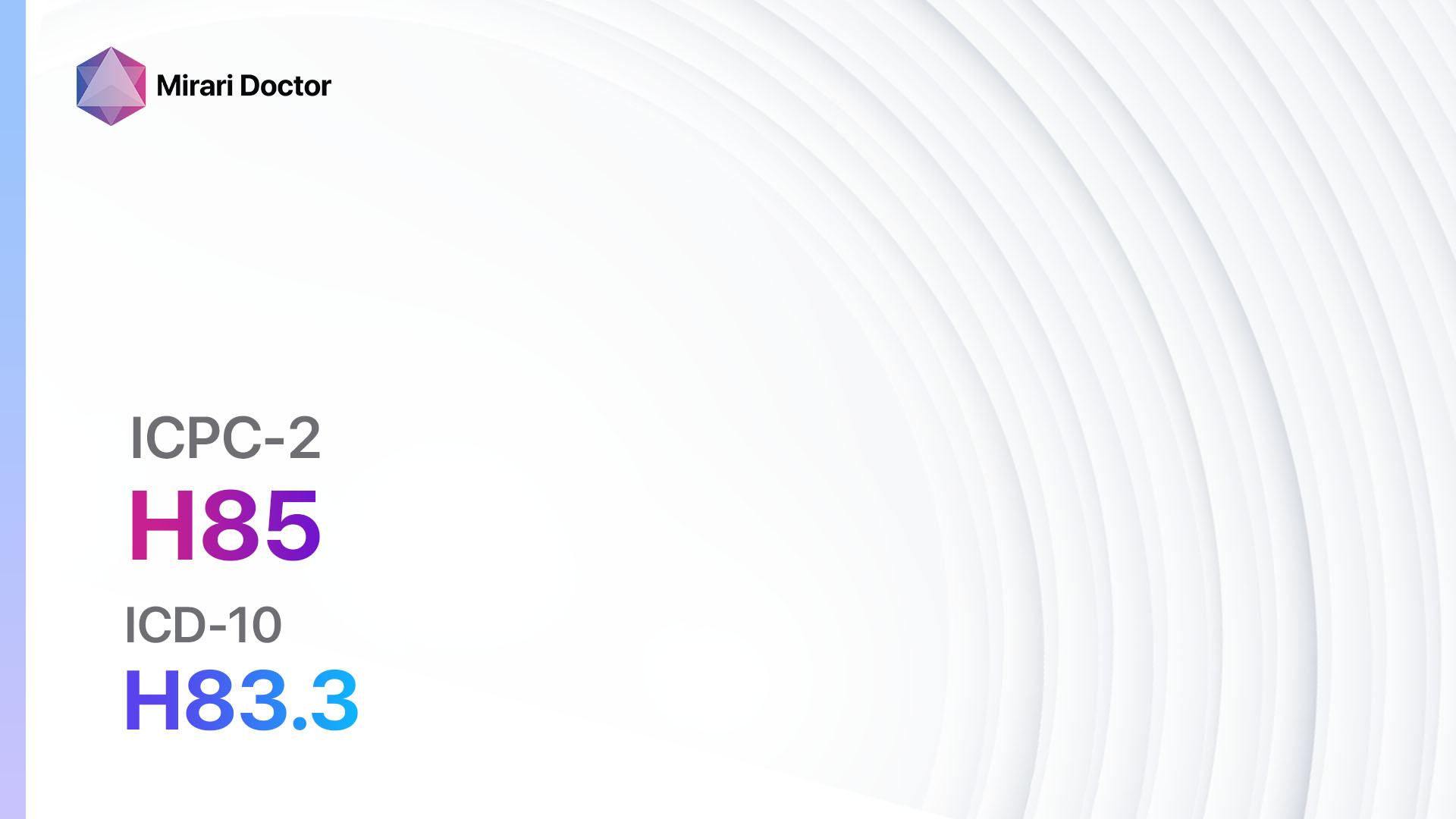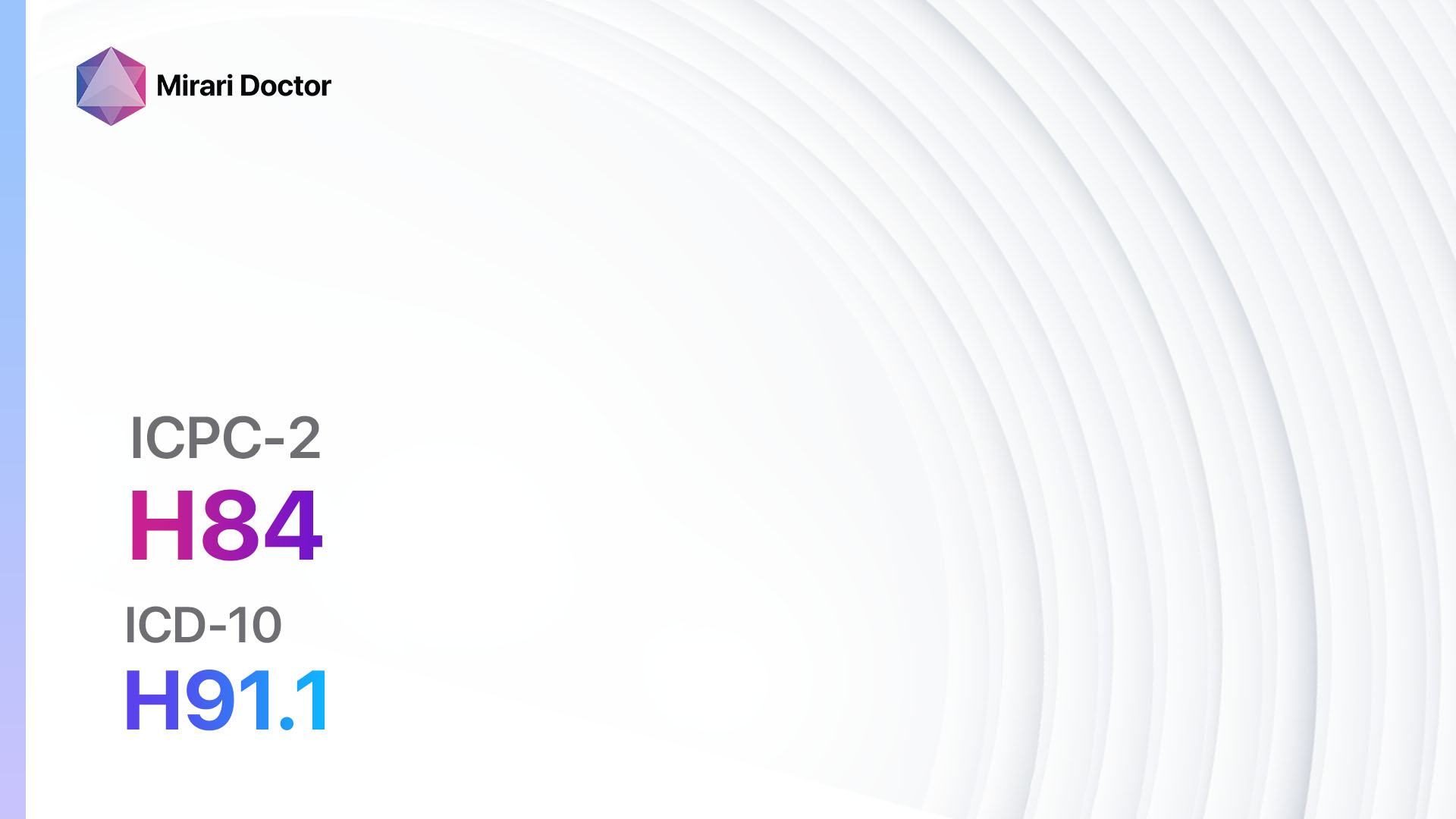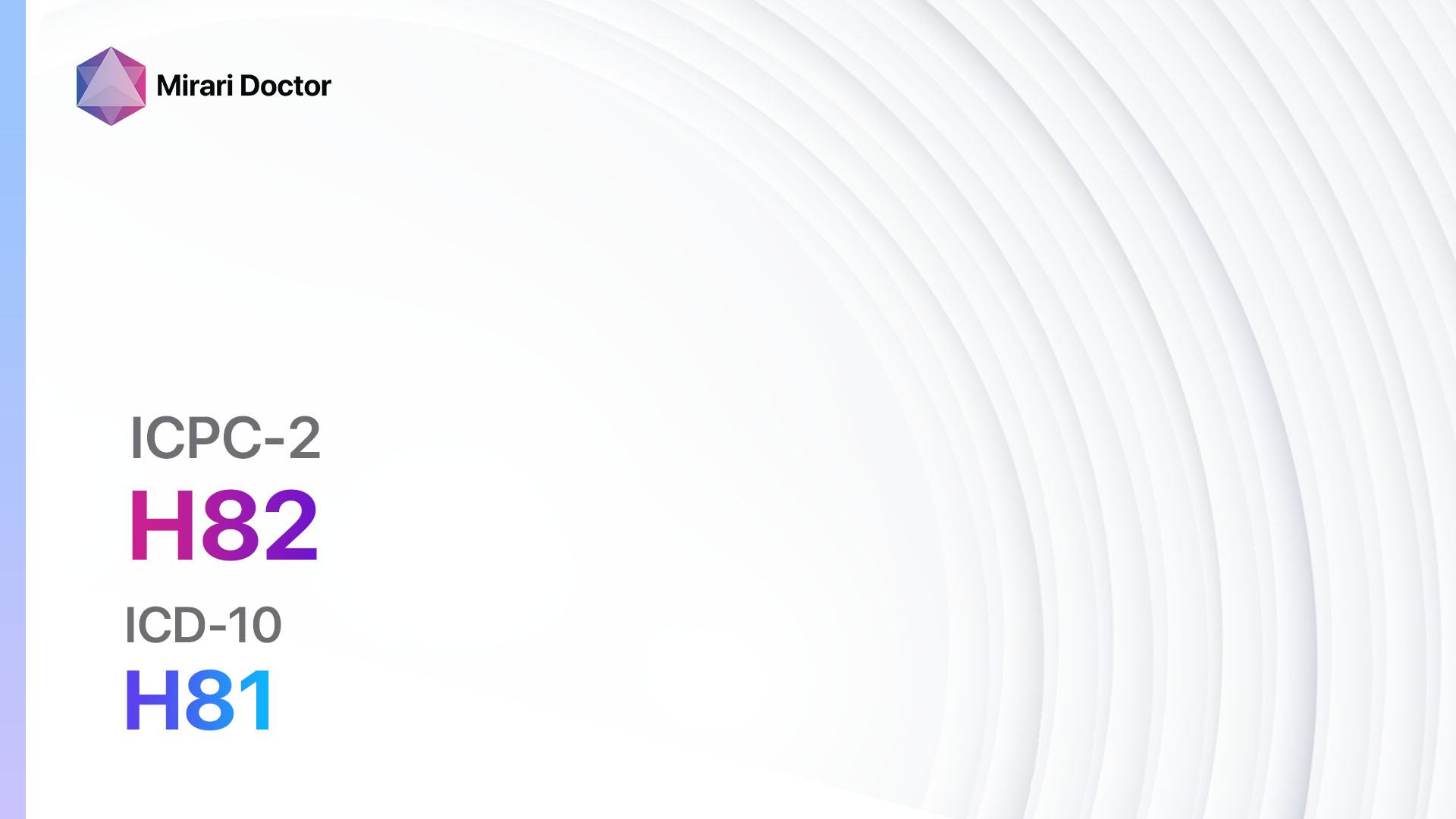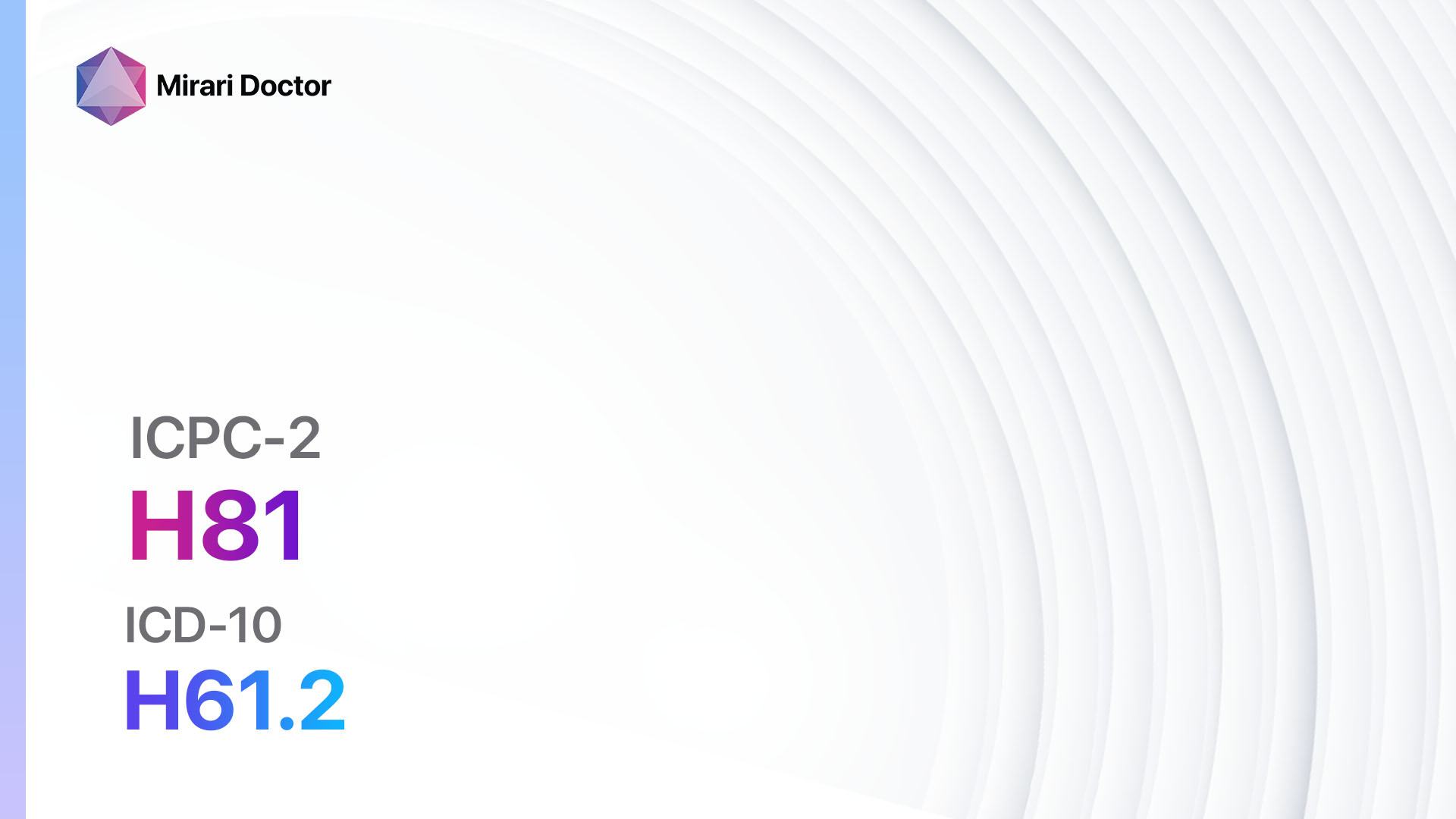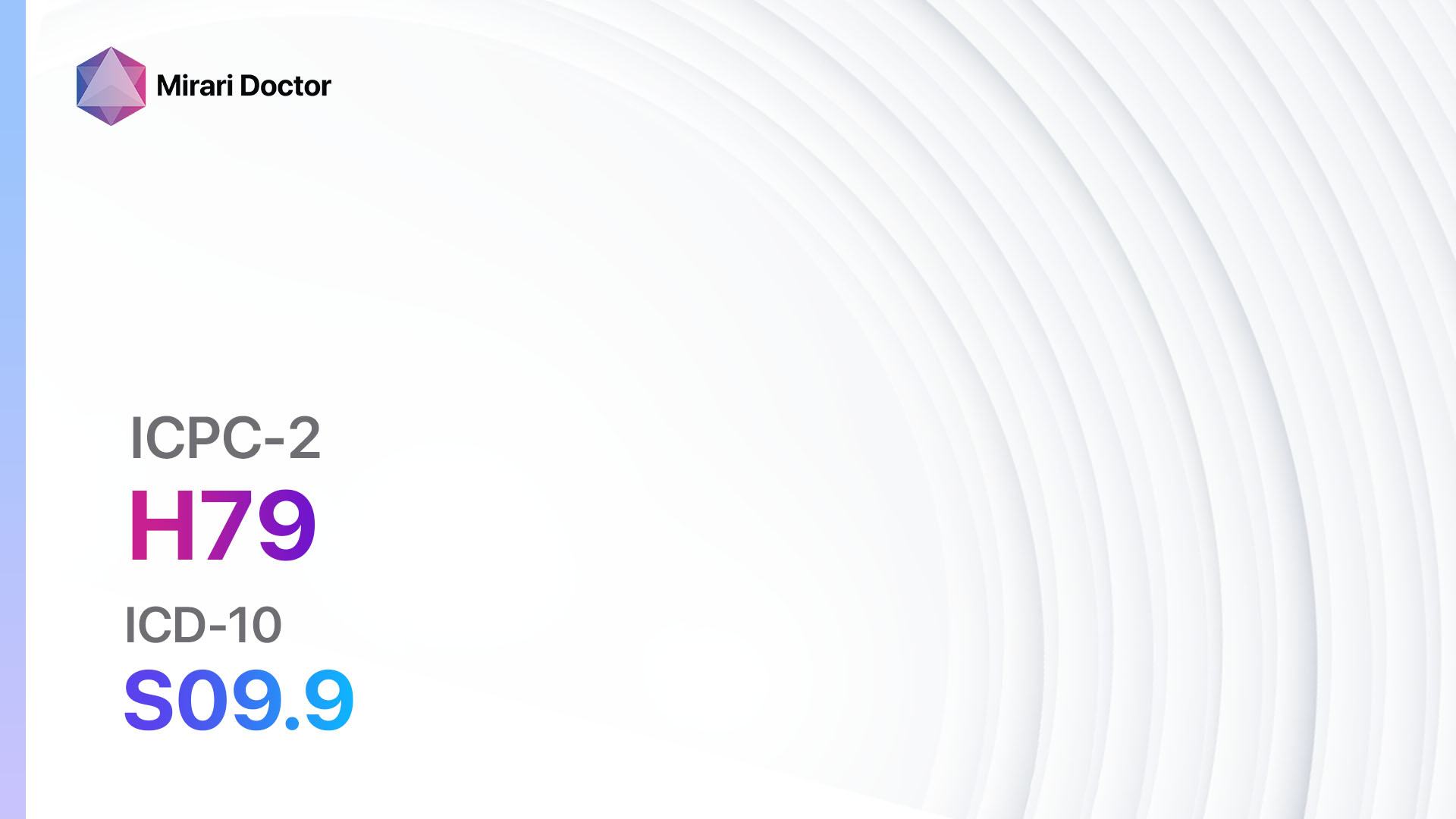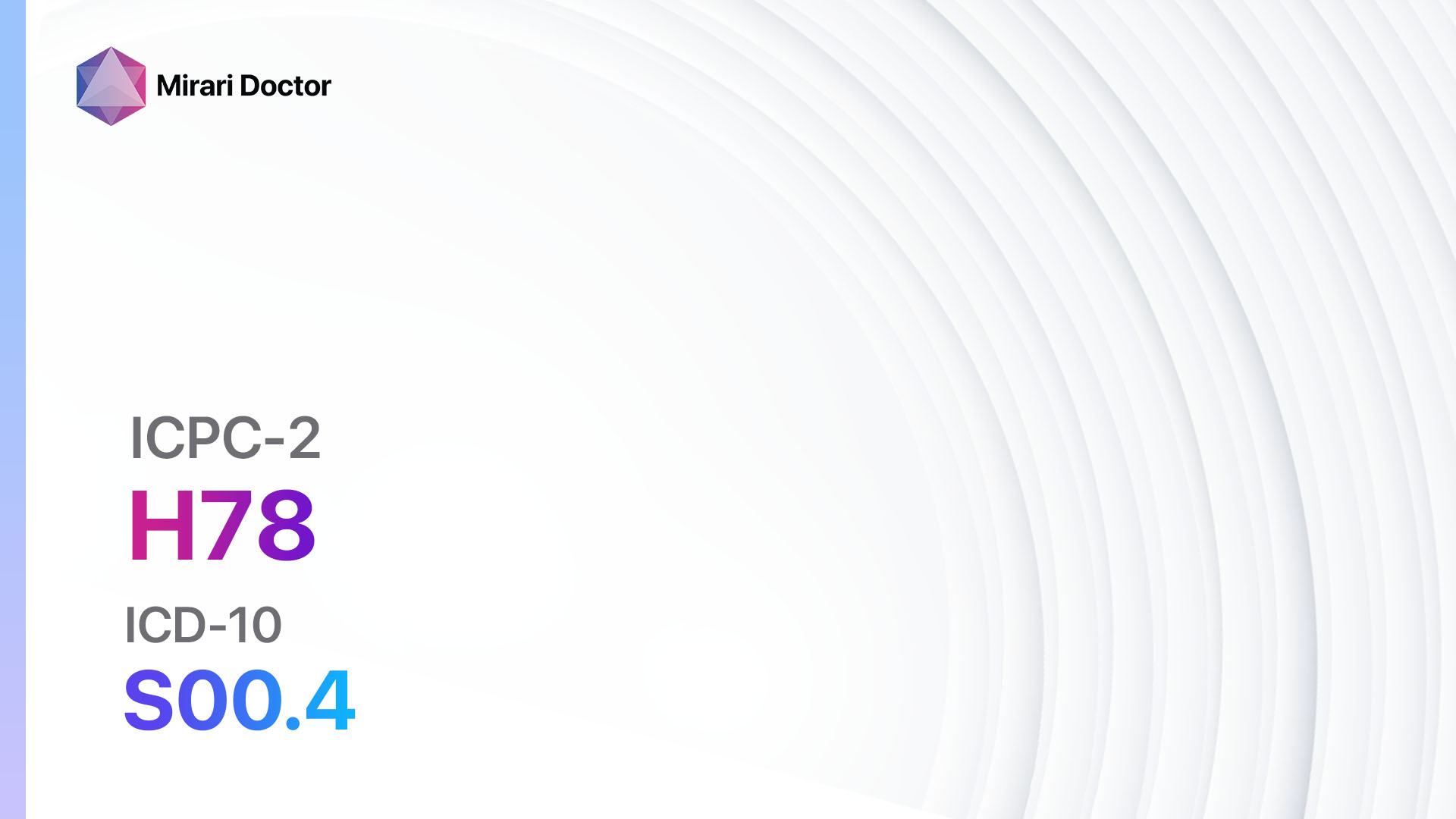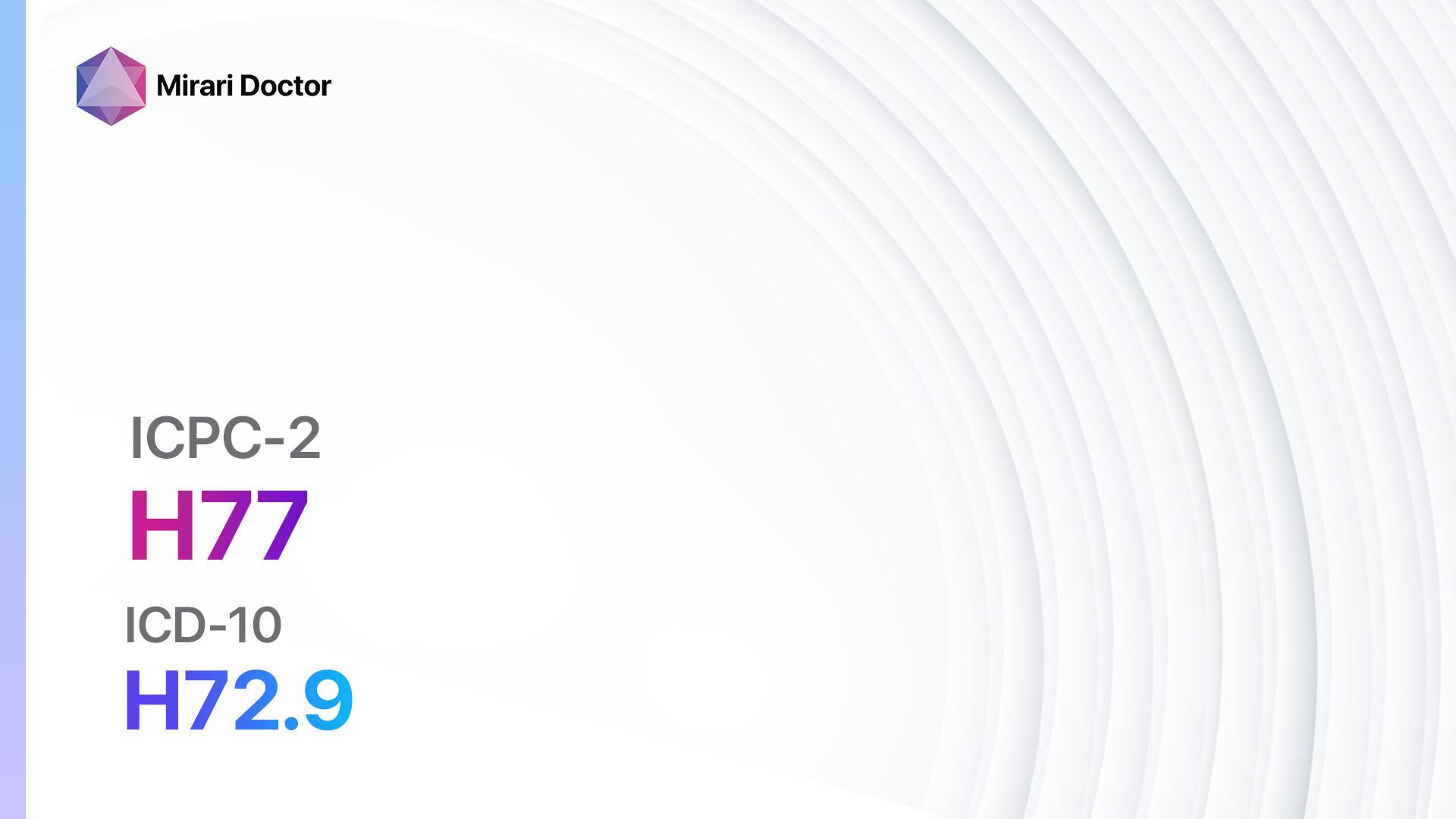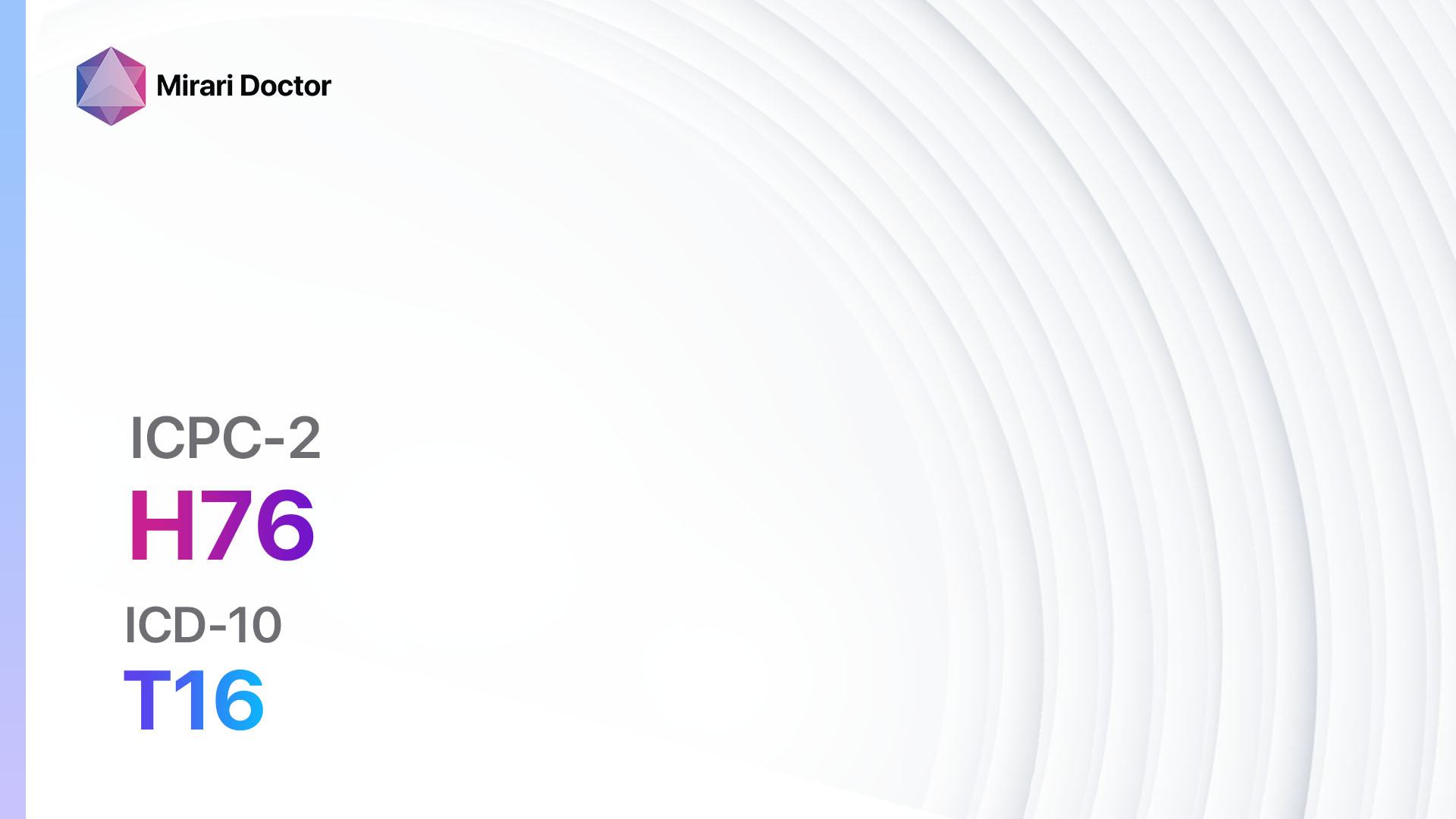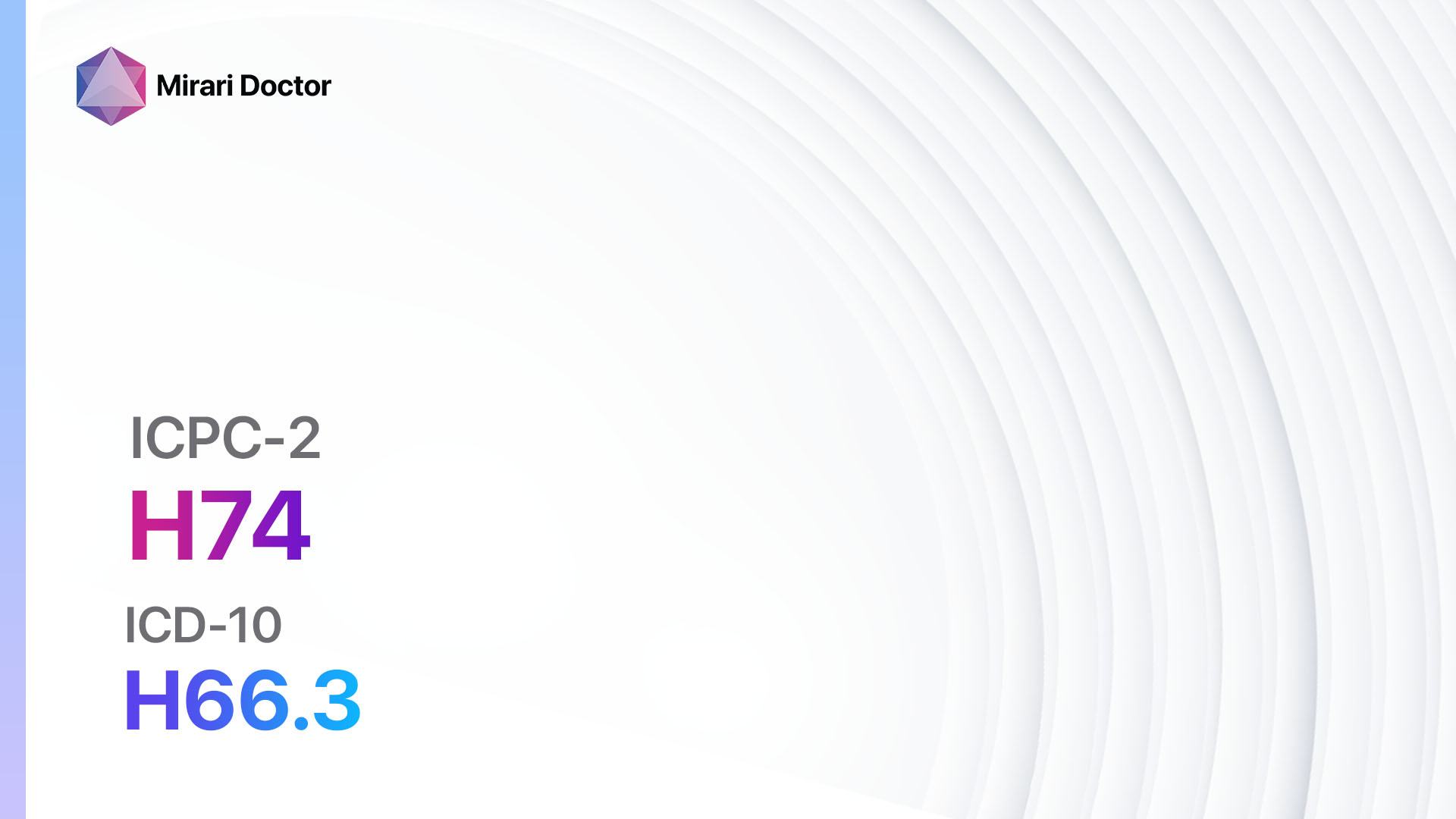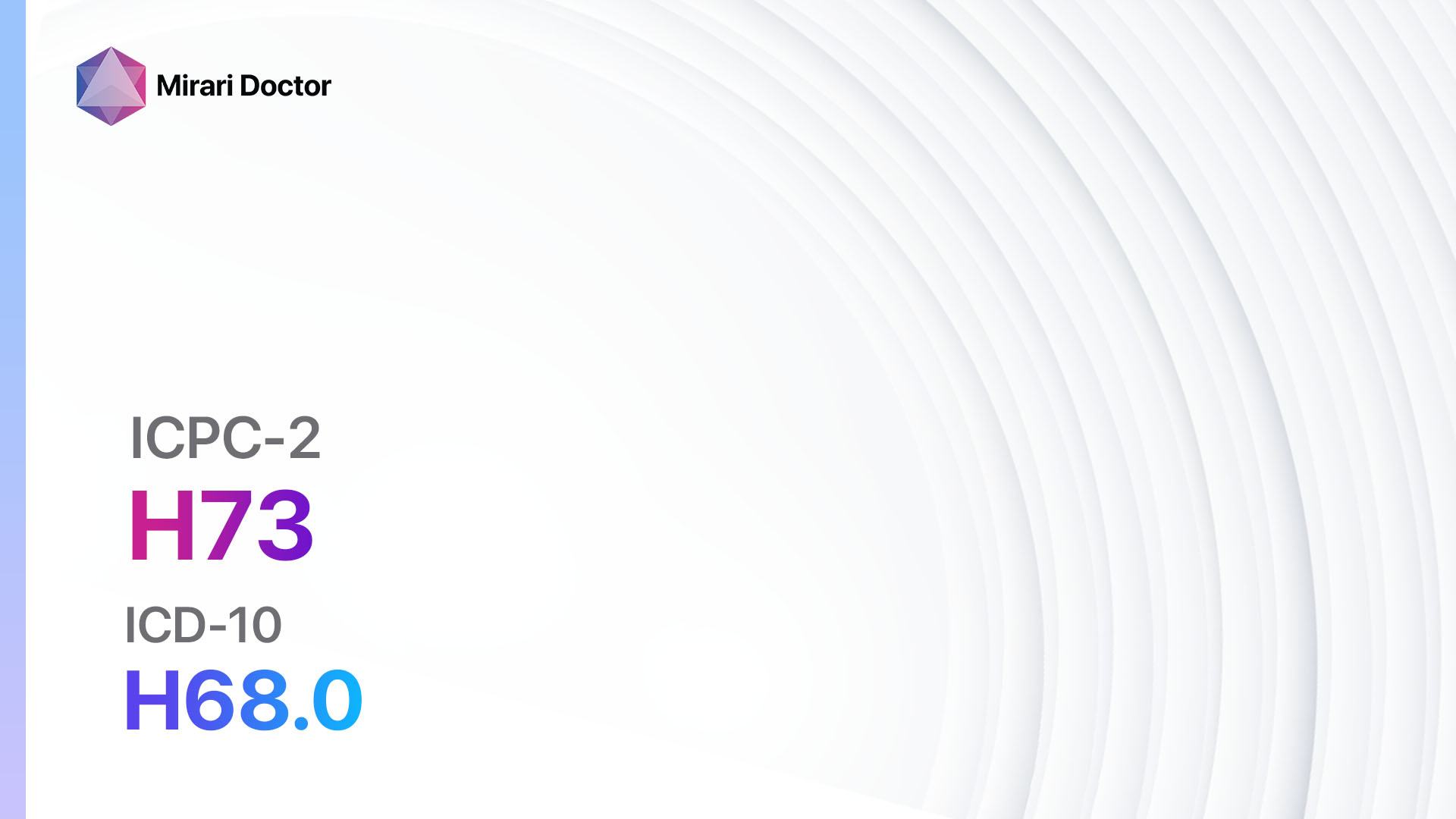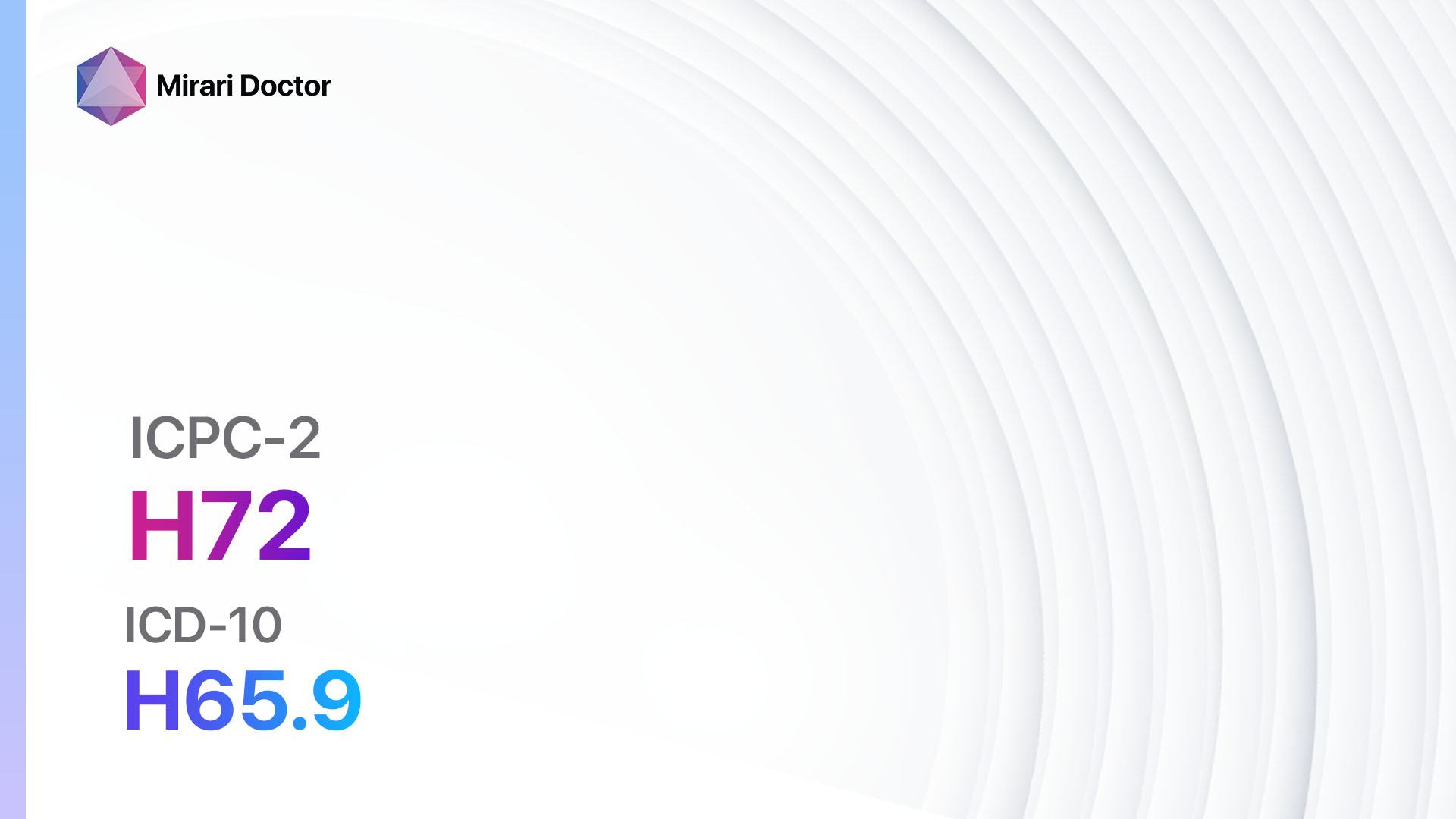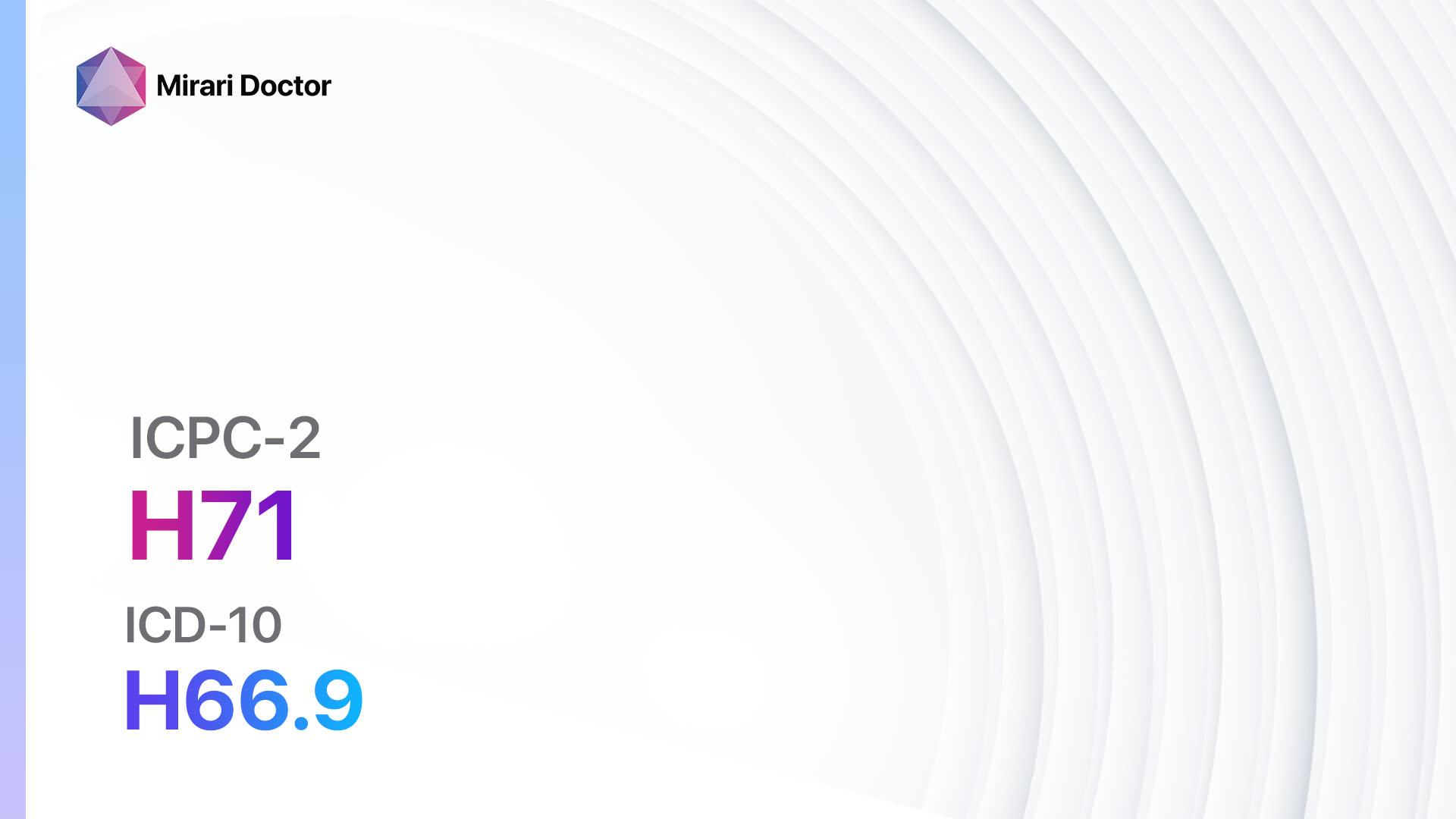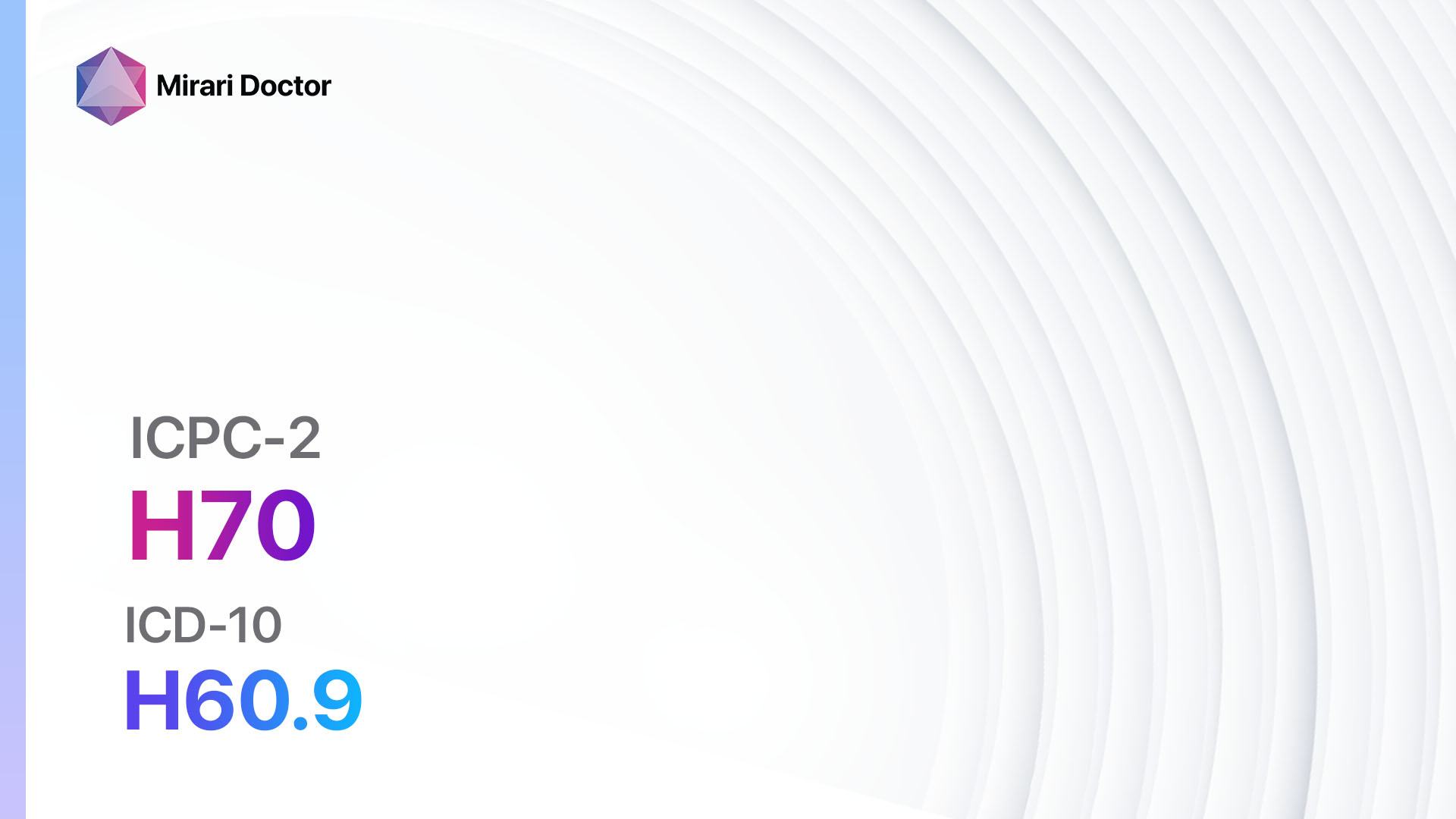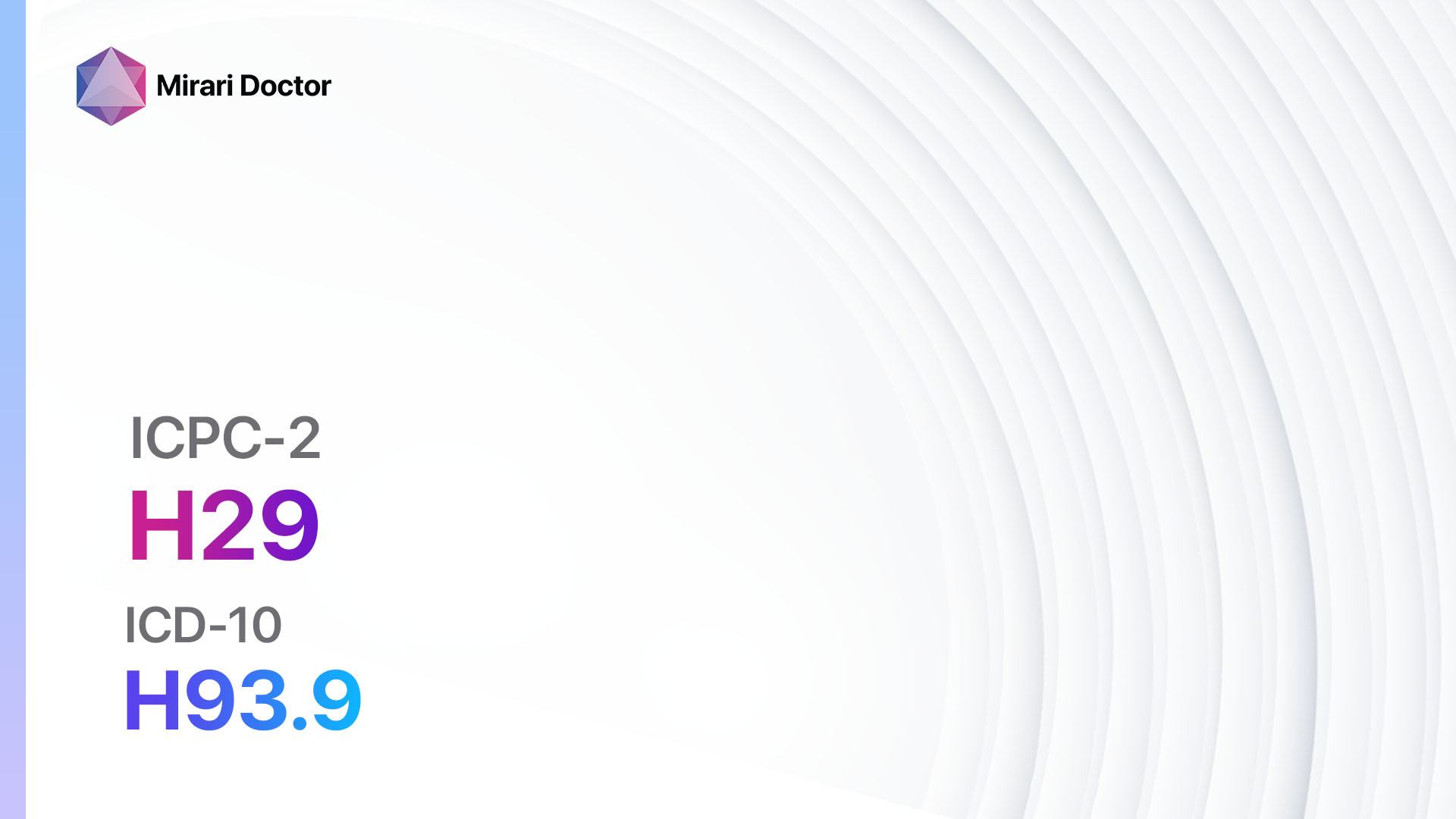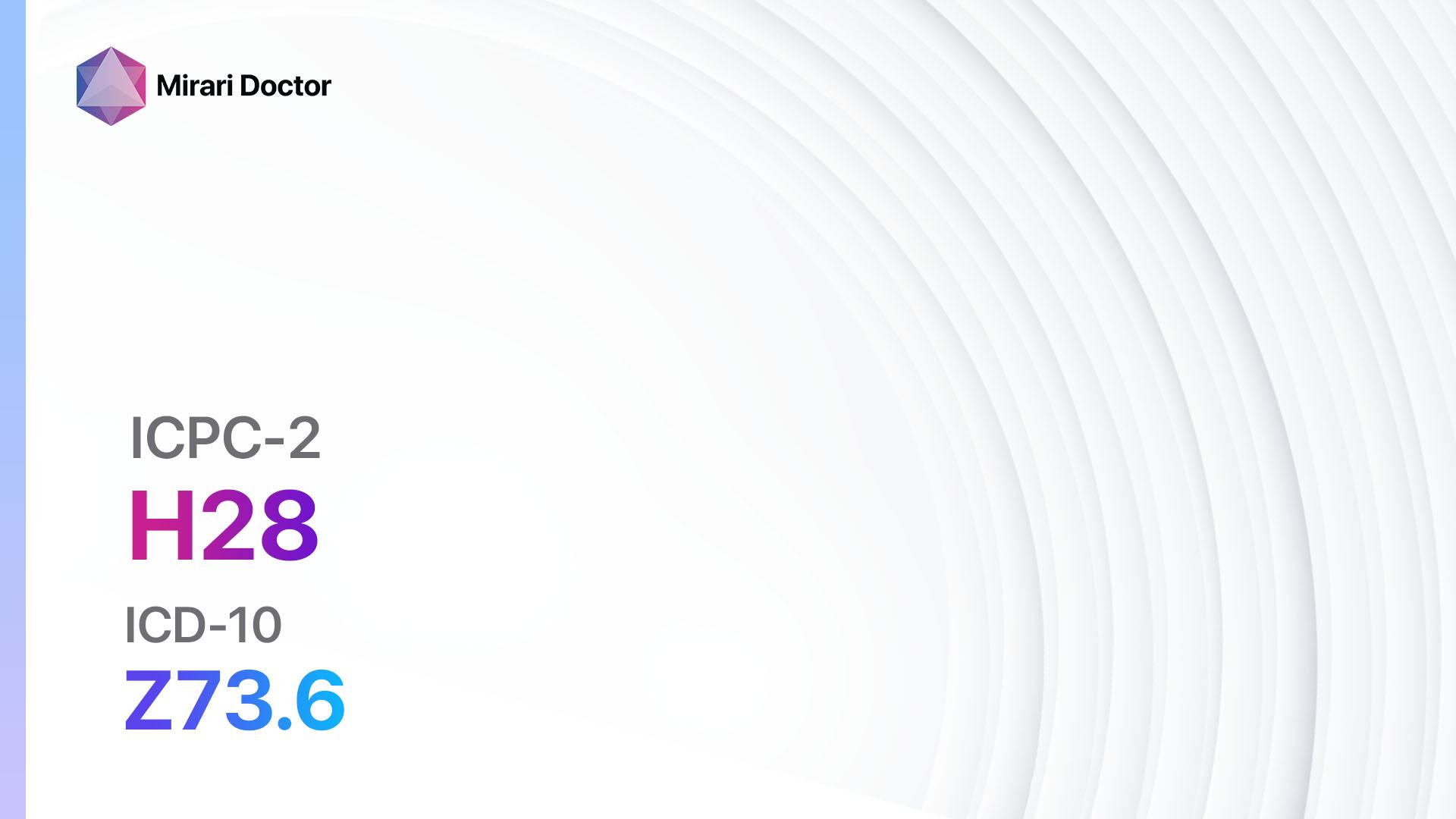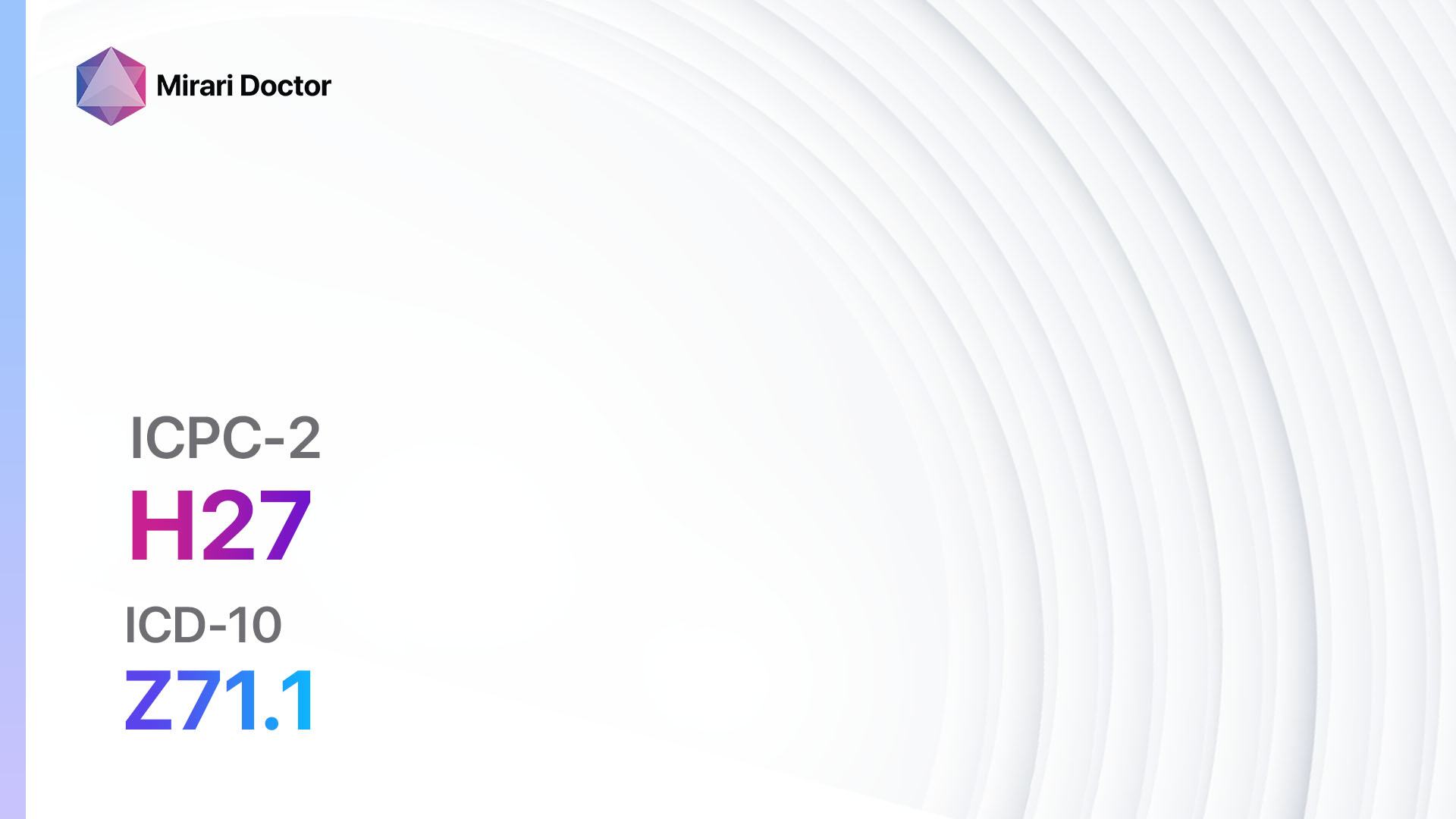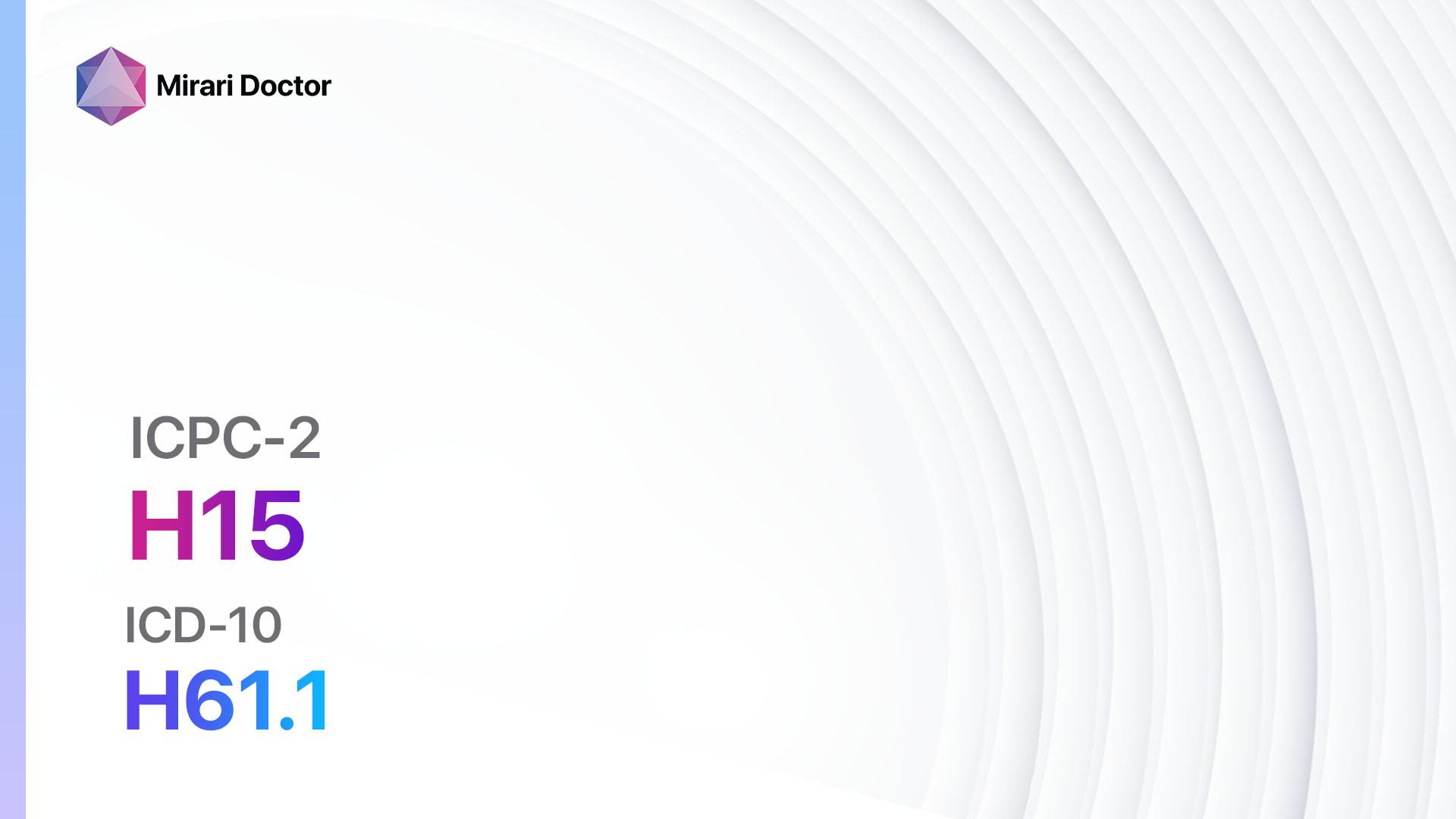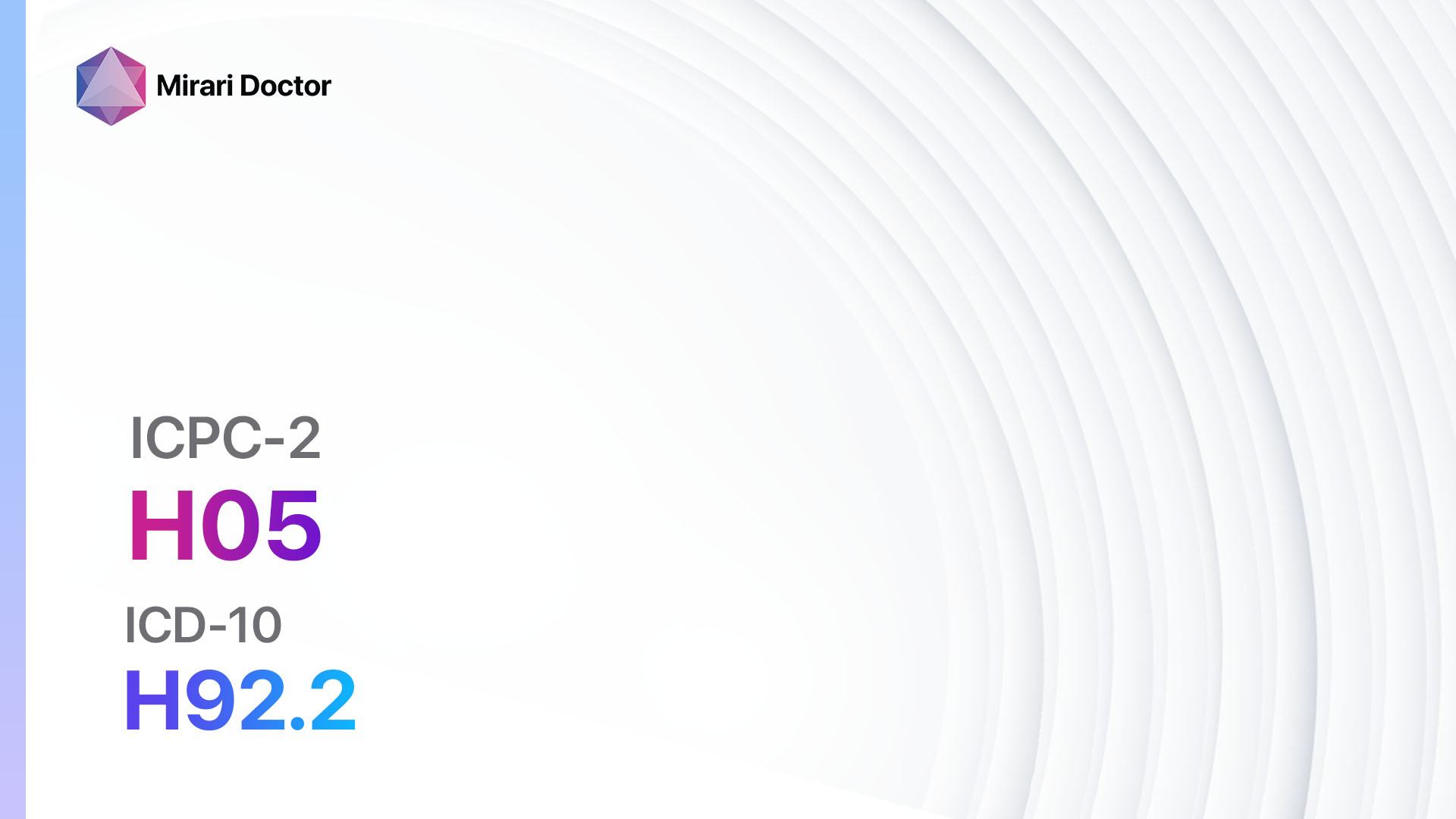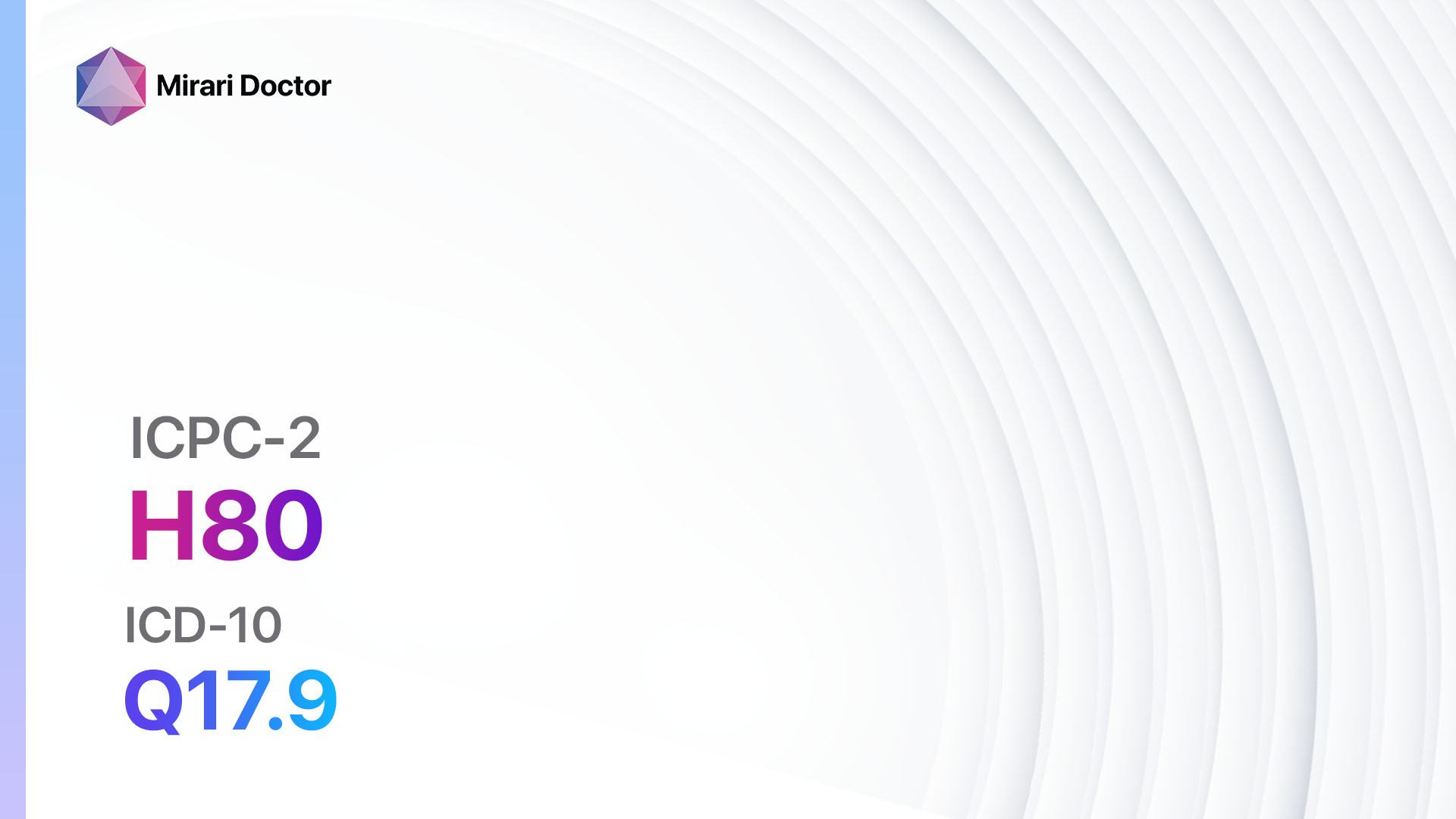
Introduction
Congenital anomalies of the ear refer to structural abnormalities present at birth that affect the development and function of the ear[1]. These anomalies can range from minor deformities to more severe malformations that can impact hearing and overall ear function[2]. The aim of this guide is to provide a comprehensive overview of the diagnosis and possible interventions for congenital anomalies of the ear.
Codes
- ICPC-2 Code: H80 Congenital anomaly of ear[3]
- ICD-10 Code: Q17.9 Congenital malformation of ear, unspecified[4]
Symptoms
- Abnormal ear shape or size[5]
- Missing or underdeveloped ear structures[6]
- Hearing loss or difficulty[7]
- Ear infections or fluid buildup[8]
- Balance problems or dizziness[9]
Causes
- Genetic factors[10]
- Exposure to certain medications or toxins during pregnancy
- Maternal infections during pregnancy
- Problems with blood supply to the developing ear
Diagnostic Steps
Medical History
- Gather information about the patient’s family history of ear anomalies or hearing loss
- Inquire about any maternal infections or exposure to medications or toxins during pregnancy
- Assess the patient’s hearing abilities and any associated symptoms
Physical Examination
- Examine the external ear for any abnormalities in shape, size, or structure
- Evaluate the ear canal and tympanic membrane for signs of infection or fluid buildup
- Assess the patient’s hearing abilities using appropriate tests, such as pure-tone audiometry
Laboratory Tests
- Genetic testing: Identify any specific genetic mutations or abnormalities associated with congenital ear anomalies
- Blood tests: Rule out any underlying medical conditions that may contribute to the development of ear anomalies
Diagnostic Imaging
- CT scan: Provide detailed images of the internal structures of the ear to assess for any malformations or abnormalities
- MRI: Evaluate the soft tissues and blood vessels of the ear for any structural anomalies
Other Tests
- Auditory brainstem response (ABR) test: Measure the electrical activity of the auditory nerve and brainstem to assess hearing function
- Otoacoustic emissions (OAE) test: Assess the function of the cochlea by measuring the sounds produced by the inner ear in response to stimuli
Follow-up and Patient Education
- Schedule regular follow-up appointments to monitor the progression of the condition and assess the effectiveness of interventions
- Provide education on proper ear care, including hygiene and infection prevention
- Offer counseling and support for patients and their families to address any emotional or psychological concerns related to the condition
Possible Interventions
Traditional Interventions
Medications:
Top 5 drugs for Congenital anomaly of ear:
- Antibiotics (e.g., Amoxicillin, Ciprofloxacin):
- Cost: Generic versions can be $3-$50/month.
- Contraindications: Allergy to antibiotics, kidney problems.
- Side effects: Upset stomach, diarrhea, rash.
- Severe side effects: Severe allergic reactions, tendon rupture.
- Drug interactions: Antacids, blood thinners.
- Warning: Finish the full course of antibiotics as prescribed.
- Corticosteroids (e.g., Prednisone, Dexamethasone):
- Cost: Generic versions can be $5-$50/month.
- Contraindications: Fungal infections, systemic infections.
- Side effects: Increased appetite, weight gain, mood changes.
- Severe side effects: Adrenal insufficiency, osteoporosis.
- Drug interactions: Nonsteroidal anti-inflammatory drugs (NSAIDs), anticoagulants.
- Warning: Do not stop taking corticosteroids abruptly.
- Antihistamines (e.g., Diphenhydramine, Loratadine):
- Cost: Generic versions can be $3-$20/month.
- Contraindications: Glaucoma, urinary retention.
- Side effects: Drowsiness, dry mouth, blurred vision.
- Severe side effects: Irregular heartbeat, seizures.
- Drug interactions: Sedatives, alcohol.
- Warning: Avoid driving or operating machinery while taking antihistamines.
- Decongestants (e.g., Pseudoephedrine, Phenylephrine):
- Cost: Generic versions can be $3-$20/month.
- Contraindications: High blood pressure, heart disease.
- Side effects: Increased heart rate, elevated blood pressure, insomnia.
- Severe side effects: Stroke, heart attack.
- Drug interactions: Monoamine oxidase inhibitors (MAOIs), beta blockers.
- Warning: Limit the use of decongestants to avoid rebound congestion.
- Antifungal medications (e.g., Clotrimazole, Fluconazole):
- Cost: Generic versions can be $5-$50/month.
- Contraindications: Liver disease, pregnancy.
- Side effects: Nausea, vomiting, skin rash.
- Severe side effects: Liver damage, allergic reactions.
- Drug interactions: Warfarin, statins.
- Warning: Follow the prescribed treatment duration and avoid alcohol consumption.
Alternative Drugs:
- Antiviral medications (e.g., Acyclovir): Used for viral infections affecting the ear.
- Antibacterial ear drops (e.g., Ciprofloxacin, Neomycin): Treat bacterial infections in the ear.
- Antifungal ear drops (e.g., Clotrimazole, Miconazole): Treat fungal infections in the ear.
- Corticosteroid ear drops (e.g., Hydrocortisone, Dexamethasone): Reduce inflammation and itching in the ear.
- Pain relievers (e.g., Acetaminophen, Ibuprofen): Provide relief from ear pain.
Surgical Procedures:
- Reconstructive surgery: Corrects structural abnormalities of the ear to improve appearance and function. Cost: $5,000 to $15,000.
- Tympanoplasty: Repairs a perforated eardrum or reconstructs the middle ear structures. Cost: $5,000 to $10,000.
- Cochlear implant: Surgically implanted device that bypasses damaged parts of the ear to provide hearing. Cost: $50,000 to $100,000.
Alternative Interventions
- Hearing aids: Assistive devices that amplify sound for individuals with hearing loss. Cost: $1,000 to $6,000 per ear.
- Speech therapy: Helps improve speech and language skills in individuals with hearing impairments. Cost: $100 to $200 per session.
- Ear molds: Custom-made earpieces that improve sound quality and comfort when using hearing aids. Cost: $100 to $300 per ear.
- Bone-anchored hearing systems: Surgically implanted device that transmits sound vibrations through the skull bone to the inner ear. Cost: $5,000 to $10,000.
- Assistive listening devices: Devices that enhance sound for individuals with hearing loss in specific situations, such as telephones or TV. Cost: $100 to $500.
Lifestyle Interventions
- Avoiding loud noises: Protecting the ears from excessive noise exposure can help prevent further damage to hearing.
- Ear hygiene: Proper cleaning and care of the ears can reduce the risk of infections and complications.
- Regular ear check-ups: Routine visits to an ear specialist can help monitor the condition and address any concerns promptly.
- Communication strategies: Learning alternative communication methods, such as sign language or lip reading, can improve communication skills for individuals with hearing loss.
- Support groups: Joining support groups or seeking counseling can provide emotional support and guidance for individuals and families affected by congenital ear anomalies.
It is important to note that the cost ranges provided are approximate and may vary depending on the location and availability of the interventions.
Mirari Cold Plasma Alternative Intervention
Understanding Mirari Cold Plasma
- Safe and Non-Invasive Treatment: Mirari Cold Plasma is a safe and non-invasive treatment option for various skin conditions. It does not require incisions, minimizing the risk of scarring, bleeding, or tissue damage.
- Efficient Extraction of Foreign Bodies: Mirari Cold Plasma facilitates the removal of foreign bodies from the skin by degrading and dissociating organic matter, allowing easier access and extraction.
- Pain Reduction and Comfort: Mirari Cold Plasma has a local analgesic effect, providing pain relief during the treatment, making it more comfortable for the patient.
- Reduced Risk of Infection: Mirari Cold Plasma has antimicrobial properties, effectively killing bacteria and reducing the risk of infection.
- Accelerated Healing and Minimal Scarring: Mirari Cold Plasma stimulates wound healing and tissue regeneration, reducing healing time and minimizing the formation of scars.
Mirari Cold Plasma Prescription
Video instructions for using Mirari Cold Plasma Device – H80 Congenital anomaly of ear (ICD-10:Q17.9)
| Mild | Moderate | Severe |
| Mode setting: 1 (Infection) Location: 0 (Localized) Morning: 15 minutes, Evening: 15 minutes |
Mode setting: 1 (Infection) Location: 0 (Localized) Morning: 30 minutes, Lunch: 30 minutes, Evening: 30 minutes |
Mode setting: 1 (Infection) Location: 0 (Localized) Morning: 30 minutes, Lunch: 30 minutes, Evening: 30 minutes |
| Mode setting: 2 (Wound Healing) Location: 0 (Localized) Morning: 15 minutes, Evening: 15 minutes |
Mode setting: 2 (Wound Healing) Location: 0 (Localized) Morning: 30 minutes, Lunch: 30 minutes, Evening: 30 minutes |
Mode setting: 2 (Wound Healing) Location: 0 (Localized) Morning: 30 minutes, Lunch: 30 minutes, Evening: 30 minutes |
| Mode setting: 3 (Antiviral Therapy) Location: 0 (Localized) Morning: 15 minutes, Evening: 15 minutes |
Mode setting: 3 (Antiviral Therapy) Location: 0 (Localized) Morning: 30 minutes, Lunch: 30 minutes, Evening: 30 minutes |
Mode setting: 3 (Antiviral Therapy) Location: 0 (Localized) Morning: 30 minutes, Lunch: 30 minutes, Evening: 30 minutes |
| Total Morning: 45 minutes approx. $7.50 USD, Evening: 45 minutes approx. $7.50 USD |
Total Morning: 90 minutes approx. $15 USD, Lunch: 90 minutes approx. $15 USD, Evening: 90 minutes approx. $15 USD, |
Total Morning: 90 minutes approx. $15 USD, Lunch: 90 minutes approx. $15 USD, Evening: 90 minutes approx. $15 USD, |
| Usual treatment for 7-60 days approx. $105 USD – $900 USD | Usual treatment for 6-8 weeks approx. $1,890 USD – $2,520 USD |
Usual treatment for 3-6 months approx. $4,050 USD – $8,100 USD
|
 |
|
Use the Mirari Cold Plasma device to treat Congenital anomaly of ear effectively.
WARNING: MIRARI COLD PLASMA IS DESIGNED FOR THE HUMAN BODY WITHOUT ANY ARTIFICIAL OR THIRD PARTY PRODUCTS. USE OF OTHER PRODUCTS IN COMBINATION WITH MIRARI COLD PLASMA MAY CAUSE UNPREDICTABLE EFFECTS, HARM OR INJURY. PLEASE CONSULT A MEDICAL PROFESSIONAL BEFORE COMBINING ANY OTHER PRODUCTS WITH USE OF MIRARI.
Step 1: Cleanse the Skin
- Start by cleaning the affected area of the skin with a gentle cleanser or mild soap and water. Gently pat the area dry with a clean towel.
Step 2: Prepare the Mirari Cold Plasma device
- Ensure that the Mirari Cold Plasma device is fully charged or has fresh batteries as per the manufacturer’s instructions. Make sure the device is clean and in good working condition.
- Switch on the Mirari device using the power button or by following the specific instructions provided with the device.
- Some Mirari devices may have adjustable settings for intensity or treatment duration. Follow the manufacturer’s instructions to select the appropriate settings based on your needs and the recommended guidelines.
Step 3: Apply the Device
- Place the Mirari device in direct contact with the affected area of the skin. Gently glide or hold the device over the skin surface, ensuring even coverage of the area experiencing.
- Slowly move the Mirari device in a circular motion or follow a specific pattern as indicated in the user manual. This helps ensure thorough treatment coverage.
Step 4: Monitor and Assess:
- Keep track of your progress and evaluate the effectiveness of the Mirari device in managing your Congenital anomaly of ear. If you have any concerns or notice any adverse reactions, consult with your health care professional.
Note
This guide is for informational purposes only and should not replace the advice of a medical professional. Always consult with your healthcare provider or a qualified medical professional for personal advice, diagnosis, or treatment. Do not solely rely on the information presented here for decisions about your health. Use of this information is at your own risk. The authors of this guide, nor any associated entities or platforms, are not responsible for any potential adverse effects or outcomes based on the content.
Mirari Cold Plasma System Disclaimer
- Purpose: The Mirari Cold Plasma System is a Class 2 medical device designed for use by trained healthcare professionals. It is registered for use in Thailand and Vietnam. It is not intended for use outside of these locations.
- Informational Use: The content and information provided with the device are for educational and informational purposes only. They are not a substitute for professional medical advice or care.
- Variable Outcomes: While the device is approved for specific uses, individual outcomes can differ. We do not assert or guarantee specific medical outcomes.
- Consultation: Prior to utilizing the device or making decisions based on its content, it is essential to consult with a Certified Mirari Tele-Therapist and your medical healthcare provider regarding specific protocols.
- Liability: By using this device, users are acknowledging and accepting all potential risks. Neither the manufacturer nor the distributor will be held accountable for any adverse reactions, injuries, or damages stemming from its use.
- Geographical Availability: This device has received approval for designated purposes by the Thai and Vietnam FDA. As of now, outside of Thailand and Vietnam, the Mirari Cold Plasma System is not available for purchase or use.
References
- Bartel-Friedrich, S. (2015). Classification and diagnosis of ear malformations. GMS Current Topics in Otorhinolaryngology, Head and Neck Surgery, 14, Doc05.
- Alasti, F., & Van Camp, G. (2009). Genetics of microtia and associated syndromes. Journal of Medical Genetics, 46(6), 361-369.
- WONCA International Classification Committee. (2005). ICPC-2-R: International Classification of Primary Care. Oxford University Press.
- World Health Organization. (2019). International Statistical Classification of Diseases and Related Health Problems (11th ed.).
- Luquetti, D. V., Heike, C. L., Hing, A. V., Cunningham, M. L., & Cox, T. C. (2012). Microtia: Epidemiology and genetics. American Journal of Medical Genetics Part A, 158A(1), 124-139.
- Kelley, P. E., & Scholes, M. A. (2007). Microtia and congenital aural atresia. Otolaryngologic Clinics of North America, 40(1), 61-80.
- Kaga, K. (2016). Congenital Anomalies of the Ear. In K. Kaga (Ed.), Neonatal and Infant Hearing Screening (pp. 15-24). Springer Singapore.
- Gopen, Q. (2011). Pathology and Clinical Course of the Inflammatory Diseases of the Middle Ear. In A. J. Gulya, L. B. Minor, & D. Poe (Eds.), Glasscock-Shambaugh’s Surgery of the Ear (6th ed., pp. 425-436). People’s Medical Publishing House.
- Sando, I., Shibahara, Y., & Takagi, A. (1988). Congenital anomalies of the inner ear. Annals of Otology, Rhinology & Laryngology, 97(5_suppl), 7-16.
- Carey, J. C., Park, A. H., & Muntz, H. R. (2006). External Ear. In S. B. Casselbrant M. L. (Ed.), Pediatric Otolaryngology (pp. 839-888). Elsevier Inc.
Related articles
Made in USA


